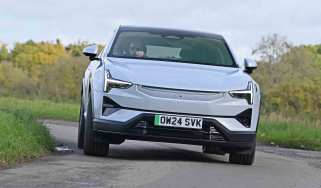Mazda CX-30 review - Interior, design and technology
Inside and out the Mazda CX-30 gives the established premium alternatives a run for their money

While the CX-30 is based on the same platform as the Mazda 3 hatchback, its bodywork is all-new. Other differences include a more practical rear third and cladding along the sills and wheel arches. Overall the result is a sleek exterior that stands out in a particularly packed market segment.
There are nine paint colours to choose from, including Mazda’s rather fetching metallic red, “Soul Red Crystal”, while higher-spec models are equipped with the larger 18-inch rims in black or silver finishes and lower-spec models with the smaller 16-inch, grey metallic versions.
As for upholstery, there are three choices: two cloth and one leather. The former is available in dark grey or black with red stitching, and the latter in black with brown accents.
The dashboard layout will be familiar to anyone who has seen the current Mazda 3, and remains well-finished and brilliantly designed. Overall, the dash is a great mix of style and function. For example, there is the right number of buttons to cope with the daily grind of driving, but it all still manages to look modern and uncluttered.
The cabin in general is a great place to be. All the parts a driver will touch the most, such as the gear knob and steering wheel, are well-sized and feel great to use. These details might seem small, but added together they create something that puts most rivals to shame.
Used - available now

2022 Mazda
Cx-30
9,850 milesAutomaticPetrol2.0L
Cash £20,287
2022 Mazda
Cx-30
17,013 milesManualPetrol2.0L
Cash £15,183
2020 Mazda
Cx-30
17,125 milesManualPetrol2.0L
Cash £18,106
2022 Mazda
Cx-30
10,666 milesManualPetrol2.0L
Cash £17,906Equipment levels are also rather good. Prime-Line trim starts the range and comes with 16-inch alloy wheels, rear parking sensors, automatic wipers, a head-up display, adaptive cruise control and air-conditioning. Centre-Line builds on this with extras such as front parking sensors, keyless entry, heated seats and a wireless charging function for your smartphone.
Homura goes even further with bigger 18-inch black alloy wheels, various black gloss trims, rear privacy glass and a power tailgate. Exclusive-Line swaps black alloys for a brighter silver finish, and also features adaptive LED headlights, a tilt-and-slide sunroof and a 12-speaker Bose sound system (the normal non-Bose system has 8 speakers). Top-of-the-range Takumi adds the black leather upholstery with brown accents, electric-adjustment for the driver's seat and a heated steering wheel.
Sat-nav, stereo and infotainment
All CX-30s now come with a 10.25-inch infotainment display, instead of the previous 8.8-inch screen. It isn’t cluttered by unnecessary information or graphics and is relatively straightforward to use. However, the Mazda’s screen does miss out on a key feature of the rest of its rivals like the VW T-Roc: there’s no touchscreen. Instead, it gets a clickwheel control similar to BMW’s iDrive controller; the main dial is surrounded by shortcut keys. Rotating the dial replicates a similar scrolling effect with the main menu functions. It’s fairly simple to use and subtle adjustments can be made on the move.
The lack of a touchscreen really hampers input speed in some areas. For instance, entering an address is a long, drawn-out process, which involves twirling the dial around to your desired letter or number, where quick prods achieve the same on rivals' systems.
Mapping display is minimalist, so route guidance is presented clearly at least, and during our testing (on the previous 8.8-inch version) we found the sub-menus’ white text on a black background is less distracting at night. Apple CarPlay and Android Auto comes as standard on the CX-30, along with Bluetooth, DAB radio and two USB-C inputs.










